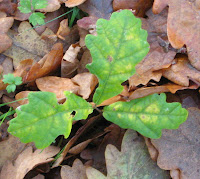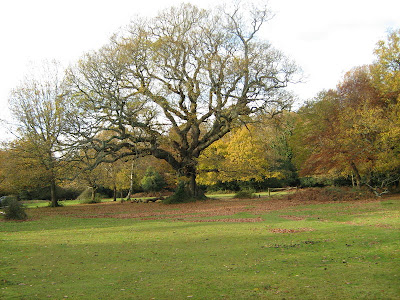
A view through the dripping brambles shows our tree in the mist. It's been one of those awful November days when the dawn seems never properly to break. But it's still beautiful walking among the autumn woods.
I've taken the view through the dripping brambles. When I was talking to our expert Hugh, he told me that a lot of naturally sown oaks depend on brambles for protection in their early years. Unlike beech, they don't grow up
through brambles, they have to grow up with them. (Oaks are much less shade-tolerant than beech.) The majority of seedlings start under the oak but very few of those survive the second year. Here is one of the seedlings that grew this year.

These year-old seedling form lovely tender food to the thousands of caterpillars that fall off the leaves (most of whom die in their turn of course, as there are not that many seedlings and lots of fallen caterpillars). Those seedlings that the caterpillars don't get, the deer or the cows or horses get instead. The acorns that are most likely to make it, are those carried away from the parent tree by jays and burried as a food supply and then not used. An oak has to be extremely lucky to survive it's first ten years. After the next ten, it becomes almost indestructible.
I was looking up through the tree at the dull grey sky and thinking that there really were quite a lot of leaves still there. But going back to the first photos I took it is easy to see how many have gone. Some of the leaves stay because oaks are descended from evergreen trees that grew in warmer climates and have not fully developed the abscission cells that break leaves off in the autumn.


Apparently leaves stay on young oaks up to 8 ft throughout the whole the winter as they do on beech and hornbeam. So please, please, please, use beech, or hornbeam (or even oak) for your hedge and never ever, ever use Leylandiai. It is impossible to keep these beastly trees in check. The trees get taller and the hedge planter gets older and soon the trees are up to 40ft and the hedge planter has rheumatism and would need to call in professional tree sugeons that would cost thousands and he wants to spend his money on cod liver oil and glucosamine and world cruises. Meanwhile the neighbours are in darkness with their flowerbeds poisoned. And both sides are hating the other through the impenetrable and virtually lifeless wood that Leylandiai
always become.
Enough, except one thing I discovered by mistake just now. Merriam Webster do a lovely illustrated dictionary showing the names of parts of things. Here's a link to a bit of it on trees.
http://visual.merriam-webster.com/plants-gardening/plants/tree/structure-tree.php
I'll end with a beautiful photograph. A line of beech and oak this morning, beautiful even on such a gloomy day. The beech are the dark brown leavers, the oak the lighter and greener ones. The green stuff at the bottom is grass except for the holly and brambles which are the dark bits.




















































